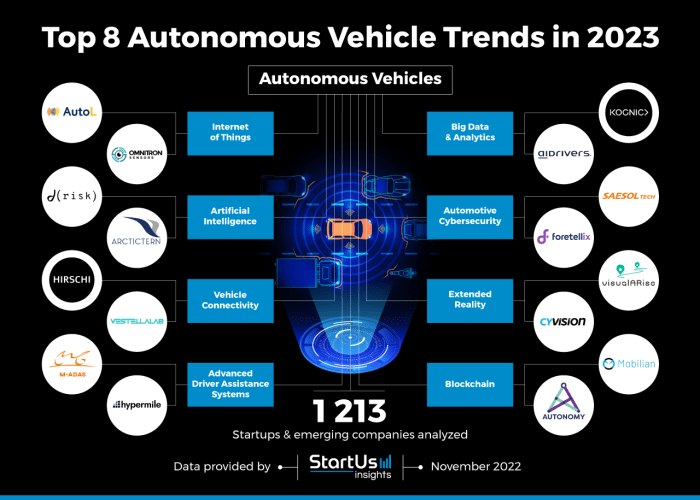Technological Advancements in Autonomous Driving

The development of autonomous vehicles relies heavily on continuous advancements across multiple technological domains. These advancements are not isolated but rather interconnected, creating a synergistic effect that drives progress towards fully autonomous driving capabilities. This section will delve into some of the key technological breakthroughs shaping the future of autonomous vehicles.
Sensor Technology in Autonomous Vehicles
Autonomous vehicles rely on a sophisticated suite of sensors to perceive their environment. LiDAR, radar, and cameras each offer unique capabilities and limitations, and often work in concert to provide a comprehensive understanding of the surroundings. The evolution of these technologies has been crucial in enhancing the safety and reliability of autonomous driving systems.
| Sensor Type | Advantages | Disadvantages | Cost |
|---|---|---|---|
| LiDAR (Light Detection and Ranging) | High-resolution 3D point cloud data, accurate distance measurement, excellent object detection in various lighting conditions. | Expensive, susceptible to adverse weather conditions (fog, rain, snow), limited range in some systems. | High |
| Radar (Radio Detection and Ranging) | Works well in adverse weather conditions, relatively inexpensive, can detect objects at long ranges. | Lower resolution than LiDAR, less accurate in identifying small objects, susceptible to interference. | Medium |
| Camera Systems | Relatively inexpensive, high resolution, provides rich visual data for object recognition and scene understanding. | Performance degraded in low light or adverse weather conditions, struggles with accurate distance measurement, susceptible to occlusion. | Low |
Advancements in AI and Machine Learning Algorithms
The core of autonomous driving is the ability to process sensor data and make intelligent decisions in real-time. This relies heavily on sophisticated AI and ML algorithms. Deep learning, in particular, has revolutionized the field. Convolutional Neural Networks (CNNs) are extensively used for image recognition and object detection, processing data from cameras and LiDAR. Recurrent Neural Networks (RNNs) excel at handling sequential data, crucial for predicting the future trajectory of other vehicles and pedestrians.
Reinforcement learning is being explored for training autonomous vehicles to make optimal decisions in complex driving scenarios. For instance, Waymo uses a combination of deep learning and reinforcement learning to train its autonomous driving system.
High-Definition (HD) Mapping and its Impact
HD mapping plays a critical role in improving the localization and path planning capabilities of autonomous vehicles. These maps are significantly more detailed than traditional navigation maps, providing precise information about lane markings, road geometry, traffic signs, and other relevant features. This detailed information allows the autonomous vehicle to accurately determine its position and plan a safe and efficient path.
The use of HD maps improves the safety and reliability of autonomous driving by reducing the reliance on real-time sensor data for critical decisions, especially in challenging environments. For example, a self-driving car might use HD map data to anticipate a sharp turn even before it is visually apparent to the vehicle’s sensors, allowing it to adjust its speed and trajectory accordingly.
Regulatory Landscape and Safety Standards

The development and deployment of autonomous vehicles (AVs) are inextricably linked to the regulatory environment and safety standards established by governments worldwide. These regulations vary significantly across jurisdictions, impacting the pace of innovation, the level of testing required, and the liability frameworks in place. A consistent and globally harmonized approach is crucial for fostering trust and enabling the safe integration of AVs into our transportation systems.
International differences in regulatory frameworks present both opportunities and challenges for the AV industry. Some countries have adopted a more proactive approach, creating specific legislation for AVs, while others are taking a more cautious, incremental approach, adapting existing regulations to accommodate emerging technologies. This disparity necessitates careful consideration by manufacturers and developers when planning for global market entry.
Autonomous Vehicle Regulations: A Comparative Overview
The following table compares and contrasts the regulatory landscapes for autonomous vehicles in the US, EU, and China, highlighting key differences in permitted automation levels, testing requirements, and liability frameworks.
| Country | Level of Automation Allowed | Testing Requirements | Liability Frameworks |
|---|---|---|---|
| United States | Varied by state; some states allow testing of highly automated vehicles (SAE Level 4 and 5), while others have more restrictive regulations. Federal guidelines are still developing. | Vary widely by state, often involving rigorous testing protocols, data logging, and reporting requirements. Specific requirements for sensor performance, cybersecurity, and fail-safe mechanisms are often included. | Generally, a complex mix of state and federal laws governing product liability, negligence, and potentially new legislation specific to AVs. Clarification on liability in the event of accidents involving AVs is still ongoing. |
| European Union | The EU is working towards a unified regulatory framework. Current regulations allow for testing under specific conditions, with a focus on safety and ethical considerations. Levels of automation are gradually being permitted based on demonstrated safety. | Stringent testing and certification procedures are being developed to ensure compliance with safety and performance standards. Emphasis on cybersecurity and data protection is high. | The EU is developing a comprehensive liability framework for AVs, aiming to address issues of responsibility in the event of accidents. This will likely involve a combination of manufacturer, operator, and potentially even system-level liability. |
| China | China has been relatively proactive in developing its AV regulations. Testing and deployment of highly automated vehicles are permitted in designated areas, with ongoing regulatory updates and refinement. | Testing regulations are evolving but generally involve stringent requirements for safety, performance, and data security. Government oversight and approval processes are central to AV development and deployment. | China’s liability framework for AVs is still developing. However, the focus is on ensuring accountability and addressing potential liabilities related to accidents involving AVs. |
Major Safety Challenges and Mitigation Strategies
Deploying autonomous vehicles presents several significant safety challenges. Addressing these challenges requires a multi-faceted approach involving technological advancements, robust testing, and effective regulatory oversight.
One major challenge is ensuring the reliable and safe operation of AVs in complex and unpredictable real-world environments. This includes handling unexpected events such as inclement weather, road construction, or the actions of other road users (pedestrians, cyclists, other vehicles). Proposed solutions involve improving sensor fusion techniques, developing more sophisticated perception algorithms, and creating robust decision-making systems capable of handling edge cases and uncertainties.
Another significant challenge is cybersecurity. AVs are highly connected systems, making them vulnerable to cyberattacks that could compromise their functionality and safety. Mitigation strategies include implementing robust security protocols, employing encryption techniques, and developing mechanisms for detecting and responding to cyber threats.
Standardized Testing and Certification
Standardized testing procedures and certification processes are critical for ensuring the safety and reliability of autonomous vehicles. These processes provide a framework for evaluating the performance, safety, and security of AV systems across various operating conditions and scenarios. They also help to build public trust and confidence in the technology.
Standardized testing often involves a combination of simulations, virtual testing environments, and real-world testing on closed tracks and public roads. The specific tests and metrics used will vary depending on the level of automation and the intended application of the AV. Certification processes typically involve independent audits and assessments to verify compliance with established safety and performance standards.
This rigorous approach helps to identify and mitigate potential risks before AVs are deployed in the broader public environment.